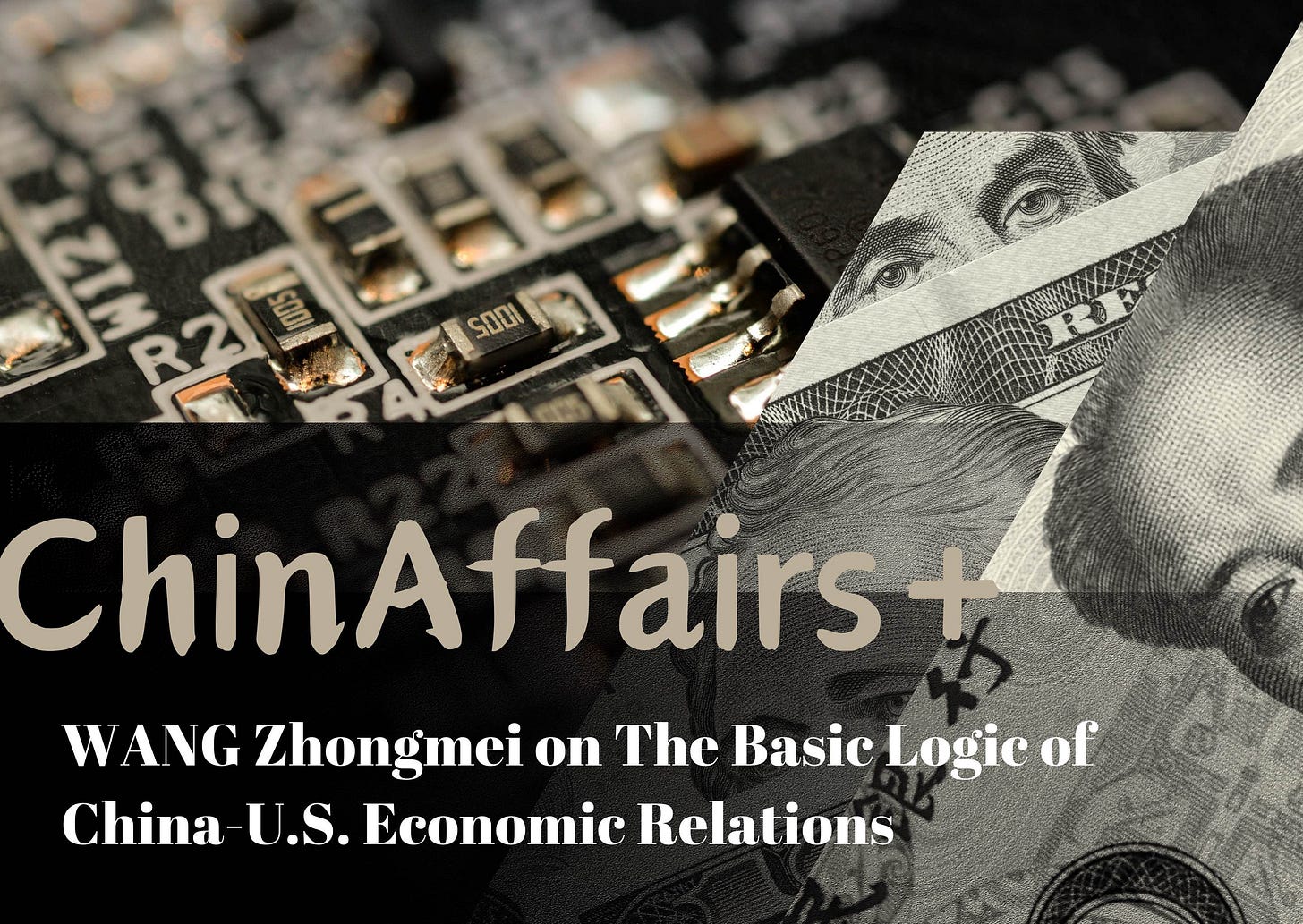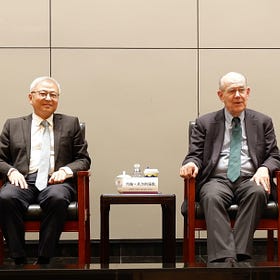WANG Zhongmei on The Basic Logic of China-U.S. Economic Relations: Long Cycle and Competition
The core content of the economic relationship between China and the United States at present and in the future is to compete for the next long-cycle advantage– technological competitiveness.
Welcome to the 13th edition of our weekly newsletter! Yesterday, I attended the 30th Stockholm China Forum in Washington DC. I joined the first session on U.S.-Europe-China dynamics after the U.S. presidential election and came away with two key impressions: uncertainty remains the dominant theme for American and European scholars regarding “Trump 2.0,” and many issues in China-Europe relations, particularly the Ukraine war and the China-Russia relationship, will not be resolved simply due to Trump’s presidency. I may write an op-ed later to elaborate on my thoughts.
ChinAffairs+ is a weekly newsletter that shares Chinese academic articles focused on topics such as China’s foreign policy, China-U.S. relations, China-European relations, and more. This newsletter was co-founded by me and my research assistant, ZHANG Xueyu. I am SUN Chenghao, a fellow with the Center for International Security and Strategy (CISS) at Tsinghua University, and currently a visiting scholar at the Paul Tsai China Center of Yale Law School in the United States.
Through carefully selected Chinese academic articles, we aim to provide you with key insights into the issues that China's academic and strategic communities are focused on. We will highlight why each article matters and the most important takeaways. Questions or criticisms may be addressed to sunchenghao@tsinghua.edu.cn
Today, we have selected an article written by WANG Zhongmei, which focuses on the basic logic of China-U.S. economic relations.
Summary
In the wake of the 2007-2008 U.S. financial crisis, besides the economic cycle factors, containing China’s rising and winning in strategic competition have become a crucial consideration in U.S. trade policy. As countercyclical regulation and industrial strategy are not completely synchronized, and there is sometimes a conflict between the two. It appears to be inevitable that competition between established and emerging powers will result in policy distortions. However, the long-cycle theory may be able to provide a perspective to explain that they are complementary, as under long-term objectives the great power will coordinate the cyclical regulation and strategic competition in the same direction. The core content of the economic relationship between China and the United States at present and in the future is to compete for the next long-cycle advantage– technological competitiveness. Although in the past China has been heavily influenced by cyclical regulation and active competition imposed by the United States, China’s trade policy is gradually becoming more independent and autonomous.
Why it matters
China-U.S. economic relations remain pivotal to the global strategic landscape, particularly amid intensifying competition over technology and economic power. The COVID-19 pandemic’s economic aftermath, coupled with trends like decoupling and “de-risking”, has reshaped the global strategic landscape. This article employs long-cycle economic theory to provide a structural analysis of the competition, emphasizing the enduring implications of technological leadership and strategic policy decisions for both nations.
By applying long-cycle theory, the article transcends short-term fluctuations to uncover the persistent competition between the U.S., as an established superpower, and China, as a rising challenger. This approach bridges economic theory with practical policy analysis, enriching discussions on trade, technology, and industrial policies. It elucidates the strategic logic driving both nations' pursuit of dominance in the evolving global order.
Furthermore, its focus on policy autonomy and interdependence resonates with broader academic and policy discussions, making it an instrumental resource for international scholars aiming to grasp the nuances of China’s approach within the global economic order.
Key points
1.Strategic Competition in the Context of the Rise and Fall of Great Powers
From an international relations perspective, the competition for great power status encompasses military, political, economic, and cultural dimensions. Among these, economic power forms the foundation of overall strength. However, in the era of globalization, the contest for economic power has become more complex than ever before. Viewed through the lens of long economic cycles, the stalemate, spiraling decline, and competitive aims of China-U.S. economic and trade relations become more apparent.
The U.S. Economic Policy under the Interpretation of Defensive Realism:
After World War II, the United States shaped the Bretton Woods system and dominated multilateral economic organizations, aligning global liberalization with its national and corporate interests. However, after the 2008 financial crisis, U.S. influence in multilateral mechanisms declined, as seen in WTO constraints during the Doha Round. Meanwhile, China's rapid growth raised U.S. concerns, prompting a shift in trade policy under Obama toward strategic alliances like the TPP, excluding China. From an offensive realism perspective, this shift sought to maximize U.S. power and curb emerging competitors through protectionism and unilateralism in an anarchic global system.
U.S. Economic Policy from the Geopolitical Perspective: Great power competition in economic policy is complex and marked by reversals and constraints shaped by economic cycles. Globalization further ties a nation’s strategic capacity to its global market position. The U.S., as a dominant power, disrupts others' policies during downturns with expansionary measures like dollar flooding and protectionism, while inflationary periods bring Federal Reserve tightening, pressuring other currencies. In contrast, China’s foreign economic policies are more constrained and reactive, heavily influenced by U.S. actions and cycles.
Sino-U.S. Economic and Trade Relations: The complexity of China-U.S. economic relations is shaped by fluctuating economic cycles, short-term goal adjustments, and competition. While short-term policies may focus on regulation or external rivalry, the long-term strategic competition between the established and rising powers is clearer, with both nations' goals aligning with broader, long-cycle objectives.
2. The Long-Cycle Perspective on U.S.-China Economic Relations
The long-cycle perspective provides valuable insights into the evolving economic competition between the U.S. and China. This view emphasizes the cyclical nature of global economic dynamics and the role of technological innovation in shaping future economic outcomes.
Economic Cycles and Innovation: Since the Industrial Revolution, global capitalism has experienced periodic cycles of boom, recession, and recovery. These cycles, known as business, trade, or economic cycles, are driven by factors like technological innovation, monetary policy, and labor productivity. Economists like Joseph Schumpeter emphasize that economic cycles are largely shaped by "creative destruction" driven by innovation.This theory helps explain how technological breakthroughs in areas like artificial intelligence (AI), biotechnology, and renewable energy could shape the future of global economic leadership, with the U.S. and China competing for dominance in the next long cycle.
Schumpeter’s Long-Cycle Theory: According to Schumpeter, major innovations that lead to productivity increases, mark the beginning of a new long cycle. The current era, dominated by AI and advanced technologies, is viewed to be potentially entering the sixth long cycle, with implications for U.S.-China competition. Schumpeter's theory posits that every long cycle consists of several shorter cycles, and each cycle is characterized by technological breakthroughs, which reshape industries and the global economy. In the case of the U.S.-China competition, technological innovation, particularly in AI and high-end manufacturing, will be the central battlefield.
Strategic Importance of Technological Innovation: The U.S. and China are in direct competition for leadership in high-tech fields. As global economic power increasingly depends on technological superiority, both nations have made strategic investments in sectors like AI, quantum computing, and renewable energy. The race for technological dominance will shape not only economic outcomes but also bring geopolitical influence. Both countries are engaged in efforts to protect their technological advancements, with the U.S. imposing export controls and the Chinese government focusing on self-reliance in critical technologies.
3. The Evolution of U.S.-China Economic Relations and the Trend of Intensified Strategic Competition
U.S.-China economic relations have evolved significantly since the 1980s, with both nations becoming increasingly interconnected. However, strategic competition has increasingly defined the relationship, especially since the 2017 U.S. administration under Donald Trump.
Impact of External Economic Cycles on Policy: U.S. economic policies, particularly those in response to global economic cycles, have had a significant impact on China. The U.S. fiscal and monetary policies, such as the Federal Reserve's interest rate adjustments and quantitative easing, have influenced global markets, affecting China’s currency, trade, and foreign investment flows. The 2008 financial crisi and subsequent U.S. actions had a profound impact on China’s economic structure and policy decisions. In response, China accelerated its domestic restructuring, focusing on reducing overcapacity and shifting toward domestic consumption.
Strategic Competition After 2017: After 2017, U.S.-China relations became increasingly dominated by strategic competition. The U.S. under Trump adopted policies that directly challenged China’s economic and technological rise, including trade tariffs and restrictions on Chinese investment in the U.S. China responded with its own policy shifts, including the establishment of free trade zones like the Shanghai Free Trade Zone and initiatives to enhance domestic innovation. The trade war escalated, and competition extended beyond trade to encompass technology and security.
Technological Rivalry and National Security Concerns: Technological competition has become the central issue in U.S.-China relations. The U.S. has imposed restrictions on Chinese technology companies, including Huawei, and expanded export controls on critical technologies such as semiconductors and AI. These measures are part of a broader strategy to limit China’s technological progress, which the U.S. sees as a threat to its global leadership. China, on the other hand, is working to strengthen its own technological capabilities, particularly in AI and electric vehicles, aiming to become a global leader in these fields.
The Future of U.S.-China Competition: As of 2020, the competition between the U.S. and China has intensified, as both countries are focusing on strategic competition in key sectors. The COVID-19 pandemic and its aftermath further complicated the relationship, when both nations adjusted their economic policies in response to the global economic downturn. China’s investments in new technologies and its focus on self-sufficiency reflect its ambition to not only reduce dependence on the U.S. but also to secure a competitive edge in the next global economic cycle. The U.S., meanwhile, has sought to decouple key industries from China, particularly in technology sectors, to maintain its competitive advantage.
Conclusion
First, economic cycles shape trade and macroeconomic policies, reflecting shifts in power. U.S. crises, such as the 2008 financial collapse and 2020 pandemic, have pressured China, whose responses—stabilizing the renminbi and prioritizing policy autonomy—show growing resilience.
Second, long-cycle regulation has emerged as the central framework for managing bilateral interactions, with technological competition increasingly defining the relationship. Post-2019, the focus has shifted from trade to cutting-edge technologies such as artificial intelligence, biotechnology, and renewable energy. Both nations are intensifying efforts to secure dominance in these areas, with the U.S. expanding export controls and China accelerating innovation and self-reliance. This technological race will remain the primary axis of policy interaction in the coming years.
Third, China must balance macroeconomic stability with internal growth, avoiding excessive intervention that risks distortions. Flexible, inclusive monetary, fiscal, and financial policies are vital for long-term development and resilience.
Finally, as strategic competition defines relations, mitigating rivalry and market distortions is crucial. Multilateral platforms like the G20 and APEC offer opportunities for collaboration, while partnerships with other economies counterbalance bilateral tensions. Pragmatic approaches are essential to ensure global stability and strategic interests.
About the Author
Wang Zhongmei 王中美:Dr. Wang Zhongmei is a Senior Research Fellow at the Center for European Studies and the Institute for World Economy Studies. Her research focuses on international competition law, innovation and competition policy, the World Trade Organization (WTO), Free Trade Agreements (FTA/RTA), and global governance. She is currently the Director of the Institute for World Economy Studies at the Shanghai Institues for International Studies(SIIS). Dr. Wang has held several prestigious academic positions, including as a visiting fellow at the Max Planck Institute for Innovation and Competition in Munich, Tartu University, the Swiss Institute of Comparative Law, the Peterson Institute for International Economics, and Victoria University in Melbourne.
About the publication
The Chinese version of the article was published by International Prospects (《国际展望》). The academic journal published by the Shanghai Institues for International Studies(SIIS) and co-organized by the Shanghai International Relations Association is China's first bilingual (Chinese bi-monthly and English quarterly) journal on international relations. International Prospects aims to provide a new academic platform for international relations research, bringing together experts and scholars from both domestic and international circles. The journal serves the development of China's international relations theory and offers advice and recommendations for China's diplomatic strategy and policies.











